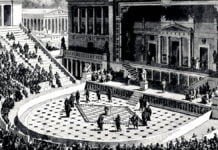Sylvia Plath wrote Lady Lazarus in 1962, during a creative burst of energy in the months before her death by suicide in 1963. It is a powerful, deeply confessional poem that explores themes of death, rebirth, suffering, and defiance. The poem alludes to the biblical story of Lazarus, whom Jesus famously resurrected. The poem’s female speaker also dies and is resurrected—multiple times, in fact, and not always happily. Each revival is akin to a circus performance for a voyeuristic, “peanut-crunching crowd” hoping to glimpse the speaker’s “scars.“ The speaker ultimately warns that she will one day rise from the ashes of her death and devour “men like air.“ The dark poem provides insight into a suicidal mind, a glimpse at the horror of being a woman in a patriarchal world, and a critique of society’s twisted fascination with suffering.
The poem is structured in short, fragmented tercets, resembling a series of disjointed, breathless confessions. The speaker, a woman who has attempted suicide multiple times, compares herself to a spectacle, likening her experiences to a theatrical performance where an audience watches her die and come back to life. She sarcastically refers to herself as “a sort of walking miracle“ and describes her self-destruction and resurrection as both horrifying and spectacular.
As the poem progresses, she invokes imagery of the Holocaust, comparing herself to Jewish victims, likening her body to “a Nazi lampshade“ and herself to an “opus“ being created in a death camp. These shocking images illustrate the dehumanisation of suffering, as well as the idea that women’s pain and trauma are often exploited for public consumption.
In the final stanzas, the speaker asserts her agency, claiming that she will rise from the ashes like a phoenix, devouring those who have oppressed her, including an ambiguous male figure often interpreted as a patriarchal force, a doctor, or even a father figure. The poem ends on an ominous, triumphant note:
“Out of the ash
I rise with my red hair
And I eat men like air.”
This final transformation suggests a shift from victimhood to empowerment, as the speaker reclaims her narrative, embracing her rebirth as an act of vengeance and renewal.
Summary
Lady Lazarus is a poem commonly understood to be about suicide. A woman narrates it, mainly addressed to an unspecified person. The narrator begins by saying she has “done it again.“ Every ten years, she manages to commit this unnamed act. She considers herself a walking miracle with bright skin, her right foot a “paperweight,“ and her face as fine and featureless as a “Jew linen”. She addresses an unspecified enemy, asking him to peel the napkin from her face, and inquiring whether he is terrified by the features he sees there. She assures him that her “sour breath“ will vanish in a day.
She is certain that her flesh will soon be restored to her face after having been sacrificed to the grave, and that she will then be a smiling, 30-year-old woman. She will ultimately be able to die nine times, like a cat, and has just completed her third death. She will die once each decade. After each death, a “peanut-crunching crowd“ shoves into see her body unwrapped. She addresses the crowd directly, showing them she remains skin and bone, unchanged from who she was before.
The first death occurred when she was ten, accidentally. The second death was intentional – she did not mean to return from it. Instead, she was as “shut as a seashell“ until she was called back by people who then picked the worms off her corpse. She does not explicitly identify how either death occurred.
She believes that “Dying / Is an art, like everything else,“ and that she does it very well. Each time, “it feels real,“ and it is easy for her. What is difficult is the dramatic comeback, the return to the same place and body, occurring as it does in broad daylight before a crowd’s cry of “A miracle!“ She believes people should pay to view her scars, hear her heart, or receive a word, touch, blood, hair or clothes from her.
In the final stanzas, she addresses the listener as “Herr Dockter“ and “Herr Enemy,“ sneering that she is his crowning achievement, a “pure gold baby.“ She does not underestimate his concern, but is bothered by how he picks through her ashes. She insists there is nothing there but soap, a wedding ring, and a gold filling. She warns “Herr God, Herr Lucifer“ to beware of her because she is going to rise out of the ash and “eat men like air.”
Confessional Poetry and Autobiographical Elements
Plath’s Lady Lazarus is one of the most well-known examples of confessional poetry, focusing on deeply personal, often taboo subjects like mental illness, trauma, and identity. Like many of Plath’s poems, Lady Lazarus is influenced by her own experiences with depression and suicide attempts, making it a deeply intimate yet universal expression of suffering.
The poem is autobiographical, yet it is also performative—the speaker adopts a persona larger than life, presenting her suffering as a theatrical event. This duality between personal pain and public spectacle is one of the most striking aspects of the poem.
Themes
Death and Resurrection
The central motif of the poem is death and rebirth, paralleling the biblical story of Lazarus but with a dark, feminist twist. The speaker’s repeated suicides are not just acts of despair but also acts of defiance, where she controls her existence and refuses to be erased.
Female Oppression and Defiance
Plath infuses the poem with a strong sense of feminist resistance. The speaker’s suffering is linked to male authority figures—doctors, spectators, and the oppressive force of patriarchy. By the end of the poem, she transforms into a powerful force, no longer a passive victim but an avenger who “eats men like air.“ This radical shift challenges the traditional perception of women as weak, passive, or tragic figures.
Art and Suffering
The poem also explores the idea that pain and suffering are commodified, particularly when it comes to women. The speaker compares herself to a work of art, an “opus,“ and a “walking miracle,“ as if her suffering exists for public consumption. This suggests a critique of how society romanticises female suffering while ignoring the real consequences of trauma.
Imagery and Symbolism
Holocaust Imagery
One of the most controversial aspects of Lady Lazarus is its Holocaust imagery, where the speaker likens herself to a Jew being burned in a concentration camp. She describes her skin as “bright as a Nazi lampshade“ and her right foot as “a paperweight.“ These images are meant to shock and disturb, drawing a parallel between personal suffering and historical atrocities. The comparison suggests that her suffering is systemic, dehumanising, and inescapable.
The Phoenix and the Cycle of Rebirth
The final image of the speaker rising “out of the ash“ with “red hair“ is reminiscent of the phoenix, a mythical bird consumed by flames and reborn from its ashes. This imagery reinforces the idea of transformation and defiance, as the speaker embraces her power instead of being destroyed by oppression.
Structure and Style
Free Verse and Short Tercets
The poem is free verse, with short, fragmented tercets that create a staccato, breathless rhythm. This disjointed structure mimics both the speaker’s unstable mental state and the fragmented nature of memory and trauma. The abrupt line breaks add to the tension, making the poem feel erratic and intense.
Repetition and Rhythm
Plath uses repetition to build intensity and rhythm. Phrases like “Dying / Is an art, like everything else“ and “I do it exceptionally well“ reinforce the speaker’s attitude toward her repeated suicide attempts, portraying them as both tragic and theatrical. The use of internal rhymes and a taunting, almost nursery-rhyme-like cadence makes the poem hauntingly rhythmic despite its dark subject matter.
Tone and Mood
The tone of Lady Lazarus is bitter, defiant, and theatrical. The speaker’s voice shifts between mocking sarcasm, deep anguish, and triumphant rage, creating a complex emotional landscape. The mood is unsettling, as the speaker moves between vulnerability and a frightening, almost supernatural power.
Influence and Legacy
Lady Lazarus remains one of Plath’s most widely studied and debated poems. Its raw exploration of mental illness, female identity, and societal expectations has made it a cornerstone of feminist and confessional poetry. Plath’s influence can be seen in later poets like Anne Sexton and Sharon Olds, who similarly explored personal trauma in their works.
The poem continues to be reinterpreted through contemporary feminist and psychological lenses, as its themes of female suffering, survival, and agency remain deeply relevant.
Lady Lazarus is a haunting, fiercely powerful poem encapsulating Sylvia Plath’s mastery of confessional poetry. The poem explores death, resurrection, female oppression, and artistic defiance through vivid imagery, shocking metaphors, and a strikingly theatrical tone. Plath’s speaker is both victim and avenger, using her suffering as empowerment. The poem remains a seminal work in feminist literature, mental health discourse, and modern poetry, making it one of the most enduring pieces of Plath’s legacy.




























